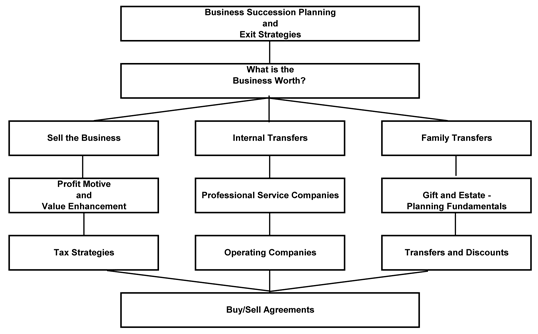
Exit planning a business opportunity for valuation practitioners “Opportunities are abundant” for business appraisers who are expanding their businesses into niche area such as succession planning, reported James Anderson (Burr Pilger Mayer) during the BVR webinar “Succession Planning & Exit Strategies: Challenges & Opportunities Today” last month. The purpose of succession planning is either to sell your business for maximum profit, transition the business to key employees, or keep the business in the family. To demonstrate these points Anderson created a schematic he dubs “parallel tracking” (see below). The far left-hand side relates to the “Sale of Business” which Anderson calls “the polishing of the apple type of scenario.” In the middle, “Internal Transfers” deal with the transfer of ownership to employees, and on the right-hand side “Family Transfers” focuses on legacy planning. The “Buy/Sell Agreements” box at the bottom ties it all together.
“Each one of these boxes – there are 12 in total - is an entrée point to about succession planning with a client,” said co-presenter Ron Seigneur (Seigneur Gustafson). “Our job is to help business owners to understand the trade-offs of each.” “The succession planning process is “a great opportunity and a great supplement to litigation work, says Anderson. And “one of my biggest source of referrals is CPAs.” Appraisers need to understand ESOP’s governance landscape October is Employee Ownership Month according to the Employee Ownership Foundation. And “as more mature, large ownership ESOPs come to dominate the landscape, governance issues have come to the forefront,” Donna Walker (Columbia Financial Advisors) told the audience at the ASA/CICBV Business Valuation Conference in Miami two weeks ago. “Valuation practitioners who work with ESOPs should be aware of important issues and trends in the ESOP arena, one of which is the role of the appraiser vis-à-vis the board of directors, trustees and fiduciaries,” says Walker. ESOPs’ increased role in corporate governance leads to greater emphasis on transparency, and with the evolving roles of ESOP trustees, advisory committees, and other groups comes the need for increased dialogue between the company and the employees. “You many want to talk to more and different people than just the CEO, CFO and trustee,” advises Walker. Impairment testing issues a result of interpretation of the regulations In a recent webinar by Valuation Research Corporation, Steve Schuetz and P.J. Patel discussed the issues they are seeing related to impairment testing. “Most of the issues are not a result of the regulations but of the interpretation of the regulations,” reports Schuetz. Recurring issues the two analysts discussed include: • Enterprise, total assets or equity valuation Click here to access the webinar. One-click: to Canadian IP valuation, it may be more than just a convenience on Amazon.comWe’ve followed the Bilsky decision closely, since it increases the potential value of business method patents. The actual Bilsky patent was rejected even if a new area of IP value was allowed in the process. The Canadian Commissioner of Patents similarly rejected Amazon’s one-click technology—it was only a business method, and not eligible for protection under section 2 of the Canadian Patent Act. In Amazon.com v. Canada (Canada Fed. Ct. 2010) the Federal Court of Canada reversed — holding that business methods can potentially be patented because (1) the system claims require a machine as an essential element of the invention and (2) the method claims are “put the into action through the use of cookies, computers, the internet and the customer’s own action” and results in a “physical effect” on those elements. So, the decision is back with the Patent Office for court-ordered speedy resolution. Every one sees this as the Canadian test case on business methods IP. It looks like Canadian appraisers will also have to look for IP value in new places—keep that in mind every time you order from Amazon! SEC’s growing focus on valuation – a market opportunity Forbes recently reported on the settlement between Robert Pinkas’ financial advisory firm Brantley Capital Management and the SEC. The SEC alleged that Pinkas significantly overstated the value of equity and debt investments in two failing private companies. The Federal judged ordered the firm to pay just under $1 million. “The issue of valuing hard-to-value assets has hovered over all sorts of investment funds holding illiquid assets ever since the credit crisis hit financial markets,” writes Nathan Vardi. “In some cases over the last year or so, prosecutors and securities regulators have undertaken investigations, but such cases are tough to prove because in the end these valuations are opinions, often signed off on by third-party valuation consultants and auditors. It would clearly be a challenge to litigate such a case,” he adds. However, the SEC enforcement division’s asset management unit is focusing on valuation issues, according to Robert Khuzami of the SEC. Click here for the complete article. Another data source sends an optimistic message on the return of large cap M&A activity BVWire doesn’t want to waste too much time on predicting what the markets will do, but we also want to highlight data from reputable sources that might affect BV practice management. Merrill DataSite recently surveyed 119 firms about their likely targets, financing plans and what industries they believe will be affected. About half of the executives surveyed expect to make an acquisition or sale in the second half of 2010, and also expect large-cap deal flow to increase in 2011. “One factor driving the higher number of current and anticipated large-cap M&A activity is a sizeable cash build-up,” says Merrill president Ed Bifulk. “ Most executives agree that valuations, while still tricky to negotiate in a choppy market, have come down since the highs of the merger boom three years ago.” The sectors with the most expected M&A activity are Banking/Finance followed by Healthcare/Pharmaceuticals. For the full report click here (registration required). Two new articles BP Calculator Peter Butler (Valtrend LLC) presented total beta theory and the Butler Pinkerton Calculator™ (BPC) at the Arizona Society of CPAs’ Business Valuation Conference earlier this month. “Total beta is a better way to quantify discount rates for privately-held companies because it captures total risk,” says Butler. Total beta assumes a completely undiversified investor (or pool of completely undiversified investors). “Is this a good assumption?” he asked the audience. “It depends on the assignment,” he answered. Butler acknowledges the controversy surrounding total beta and the BPC, and suggests using the BPC as one of many tools to determine COC. Two recent articles about BPC are now available on the BVR website: “Total Beta and the Butler Pinkerton Calculator: An Anthology” and “Total Beta - An International Perspective: A CanadianExample.” For more information about the BPC click here. Webinars this week and next you won’t want to missThursday, October 21: “Valuation Issues in Shareholder Dissent & Oppression” Join BVR and expert presenters Jay Fishman and Gil Matthews for an in-depth look at the challenges and nuances of this expansive field, including emerging case law, fair value standards unique to dissent & oppression cases, and the importance and scrutiny of discounted cash flow analyses. Two CPE credits available. Friday, October 22: “The Use of Forensic Evidence in Lost Profits Cases” Part 3 of our Webinar Series on Damages Essentials focuses on the complex rules of evidence governing lost profits analyses and cases. Expert presenters Michael Kaplan and Rebekah Smith will show how an appraiser can use the courts rules to his or her advantage. Two CPE credits available. Wednesday, October 27: “A Guided Tour of BVLaw™” BVR’s latest free webinar features Publisher Doug Twitchell providing an introduction to the exclusive BVLaw™, a collection of over 3,000 cases and case abstracts concerning business valuation issues including economic damages, lost profits, estate and gift tax, divorce, shareholder repression, partnership dissolution, securities litigation—and more. Registration is free. One CPE credit available. Mercer offers free webcast on buy-sell agreements To ensure this email is delivered to your inbox, Copyright © 2010 by Business Valuation Resources, LLC
|
|



